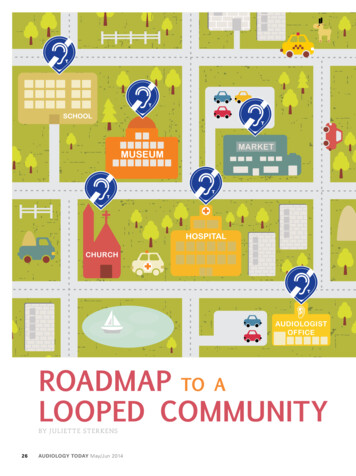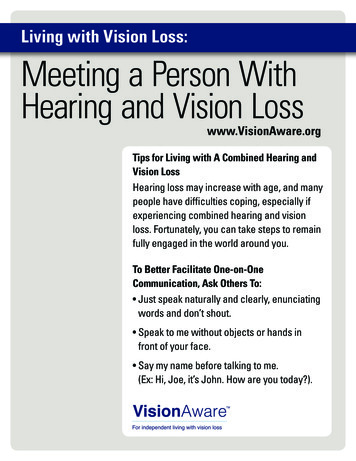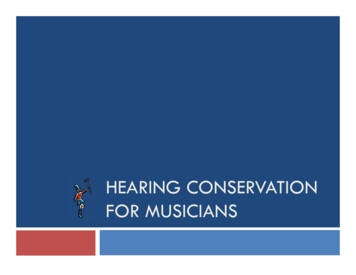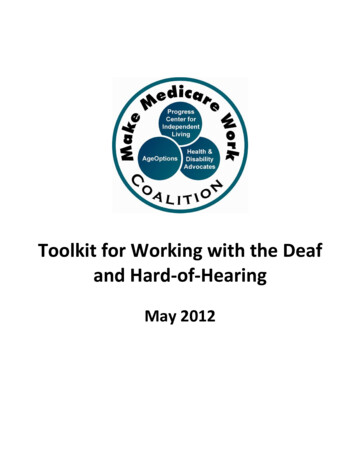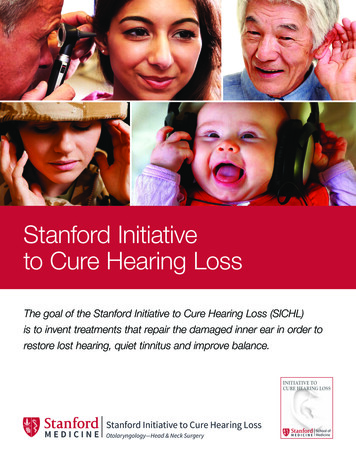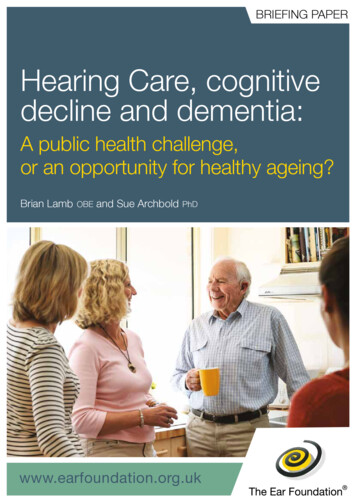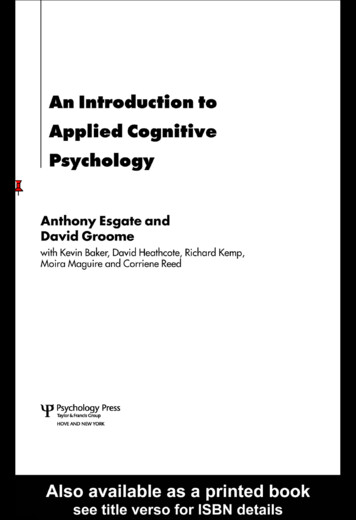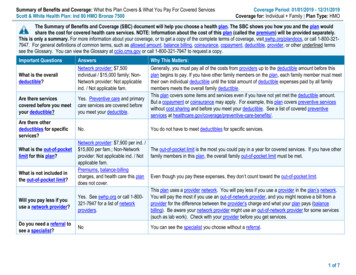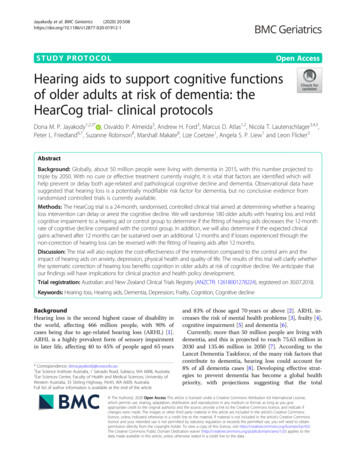
Transcription
Jayakody et al. BMC Geriatrics(2020) UDY PROTOCOLOpen AccessHearing aids to support cognitive functionsof older adults at risk of dementia: theHearCog trial- clinical protocolsDona M. P. Jayakody1,2,3* , Osvaldo P. Almeida3, Andrew H. Ford3, Marcus D. Atlas1,2, Nicola T. Lautenschlager3,4,5,Peter L. Friedland6,7, Suzanne Robinson8, Marshall Makate8, Lize Coetzee1, Angela S. P. Liew1 and Leon Flicker3AbstractBackground: Globally, about 50 million people were living with dementia in 2015, with this number projected totriple by 2050. With no cure or effective treatment currently insight, it is vital that factors are identified which willhelp prevent or delay both age-related and pathological cognitive decline and dementia. Observational data havesuggested that hearing loss is a potentially modifiable risk factor for dementia, but no conclusive evidence fromrandomised controlled trials is currently available.Methods: The HearCog trial is a 24-month, randomised, controlled clinical trial aimed at determining whether a hearingloss intervention can delay or arrest the cognitive decline. We will randomise 180 older adults with hearing loss and mildcognitive impairment to a hearing aid or control group to determine if the fitting of hearing aids decreases the 12-monthrate of cognitive decline compared with the control group. In addition, we will also determine if the expected clinicalgains achieved after 12 months can be sustained over an additional 12 months and if losses experienced through thenon-correction of hearing loss can be reversed with the fitting of hearing aids after 12 months.Discussion: The trial will also explore the cost-effectiveness of the intervention compared to the control arm and theimpact of hearing aids on anxiety, depression, physical health and quality of life. The results of this trial will clarify whetherthe systematic correction of hearing loss benefits cognition in older adults at risk of cognitive decline. We anticipate thatour findings will have implications for clinical practice and health policy development.Trial registration: Australian and New Zealand Clinical Trials Registry (ANZCTR: 12618001278224), registered on 30.07.2018.Keywords: Hearing loss, Hearing aids, Dementia, Depression, Frailty, Cognition, Cognitive declineBackgroundHearing loss is the second highest cause of disability inthe world, affecting 466 million people, with 90% ofcases being due to age-related hearing loss (ARHL) [1].ARHL is a highly prevalent form of sensory impairmentin later life, affecting 40 to 45% of people aged 65 years* Correspondence: dona.jayakody@uwa.edu.au1Ear Science Institute Australia, 1 Salvado Road, Subiaco, WA 6008, Australia2Ear Sciences Centre, Faculty of Health and Medical Sciences, University ofWestern Australia, 35 Stirling Highway, Perth, WA 6009, AustraliaFull list of author information is available at the end of the articleand 83% of those aged 70 years or above [2]. ARHL increases the risk of mental health problems [3], frailty [4],cognitive impairment [5] and dementia [6].Currently, more than 50 million people are living withdementia, and this is projected to reach 75.63 million in2030 and 135.46 million in 2050 [7]. According to theLancet Dementia Taskforce, of the many risk factors thatcontribute to dementia, hearing loss could account for8% of all dementia cases [8]. Developing effective strategies to prevent dementia has become a global healthpriority, with projections suggesting that the total The Author(s). 2020 Open Access This article is licensed under a Creative Commons Attribution 4.0 International License,which permits use, sharing, adaptation, distribution and reproduction in any medium or format, as long as you giveappropriate credit to the original author(s) and the source, provide a link to the Creative Commons licence, and indicate ifchanges were made. The images or other third party material in this article are included in the article's Creative Commonslicence, unless indicated otherwise in a credit line to the material. If material is not included in the article's Creative Commonslicence and your intended use is not permitted by statutory regulation or exceeds the permitted use, you will need to obtainpermission directly from the copyright holder. To view a copy of this licence, visit http://creativecommons.org/licenses/by/4.0/.The Creative Commons Public Domain Dedication waiver ) applies to thedata made available in this article, unless otherwise stated in a credit line to the data.
Jayakody et al. BMC Geriatrics(2020) 20:508number of people living with dementia could be reducedby 13% if the onset of symptoms could be delayed bytwo years or more [9].Australian data from the Health In Men Study showedthat in a sample of 37,898 older men, the hazard of dementia associated with hearing impairment was 1.69(95%CI 1.54, 1.85) [10]. In addition, a systematic review of 14 prospective studies showed that hearing losswas associated with a 49% (95%CI 30–67%) increase inthe hazard of dementia [10]. Whilst this data shows aclear association between hearing loss and cognitive impairment, a causal relationship cannot be definitively determined, and it is currently not known whether thecorrection of hearing loss through the use of hearingaids can decrease the rate of cognitive decline or reducedementia risk.Our trial aims to investigate whether the correction ofhearing loss through the use of hearing aids (HAs) coulddecrease the 12-month rate of cognitive decline amongolder adults at risk of dementia.MethodsAims1. This trial will determine whether the correction ofhearing loss through the use of hearing aids (HA)decreases the 12-month rate of cognitive declineamong older adults at risk of dementia.2. We will also investigate whether the correction ofhearing loss has a beneficial impact on memory andexecutive functions, anxiety and depressivesymptoms, quality of life, physical health, andhealth-related costs over 12 months.3. We will explore whether the expected clinical gainsachieved through the correction of hearing loss by12 months can be sustained over an additionalperiod of 12 months and if losses experiencedthrough the non-correction of hearing loss can bereversed with the fitting of HAs after 12 months(i.e., HAs fitting for controls at 12 months with follow up of 12 months).Page 2 of 8place advertisements in the local media and primary carenetworks, inviting interested participants for screening.If the recruitment of participants is lower than predicted,we will use the electoral roll list to select a random listof people aged 70 years living the study areas: they willreceive information about the study and an invitation tocontact the research office for screening if they believethey may be potentially eligible (the mail out will be deidentified – i.e., investigators will not have access to thelist). This approach has been used successfully in otherstudies.Eligibility criteriaParticipants will: Be older adults aged 70 years or older (cognitivedecline is more pronounced later in life). Have a Montreal Cognitive Assessment for theHearing Impaired (HI-MOCA [11] greater than 18and less than 26 (mild impairment). Have better ear average hearing loss at 0.5, 1 & 2kHz (3FAHL) 23 dB or high-frequency averagehearing loss (2, 3 & 4 kHz) (HFAHL) 40 dB asmeasured using air conduction pure-tone audiometry (HA fitting criteria recommended by HearingServices Program in Australia for older adults withARHL [12]. Be fluent English speakers.Exclusion criteriaWe will exclude participants who: Have impaired instrumental activities of daily living Study designTwo-arm parallel randomised controlled trial.Participants and settingWe will recruit 180 older adults with mild cognitive impairment and hearing loss. The trial will be conducted atthe Ear Science Institute Australia (ESIA) based in thePerth and Bunbury metropolitan regions, WesternAustralia as well as the Western Australian Centre forHealth & Ageing, Perth, Australia. Participants will berecruited from the ESIA hearing clinics, aged-carehomes, and hospital memory clinics. In addition, we will (IADL) [13] due to cognitive deficits (requiresassistance or is dependent in the use of telephone,shopping, housekeeping, laundry, transport,management of medications and finances) – i.e.have dementia [14] or major neurocognitivedisorder.Meet clinical criteria for cochlear implantation(unaided bilateral sensorineural hearing loss 70dBHL, and open-set sentence scores in quiet in theworse ear 65% and in the better ear 85% or openset phoneme scores in quiet in the worse ear 45%and in the better ear 65% with optimised HA fitting [15].Have visual impairment that limits participant’sability to read Times New Roman font size 16 (arequirement for two sentences of HI-MOCA).Have a severe medical illness that limits the abilityof the participant to attend appointments or sustainparticipation in the study for 24 months.Plan to move away from the study area during thesubsequent 24 months.
Jayakody et al. BMC Geriatrics(2020) 20:508 Are unable or unwilling to provide written,informed consent to participate. Are unable to complete the motor screening task(MOT) module of the CambridgeNeuropsychological Test Battery (CANTAB) due tovisual impairment, inability to comprehend testinstructions or inability to attend to the task due todexterity problems [16].InterventionThe intervention consists of three parts: (i) hearing assessment and HA discussion, (ii) HA fitting, verificationand validation and (iii) HA review following daily use ofHAs.The intervention will be carried out by a qualifiedaudiologist according to the Australian Audiological Society Standards in a standardised soundproof booth. Allparticipants will be given a pair of Oticon OPN 1S hearing aids.Page 3 of 8primarily sensitive to medial temporal lobedysfunction. Paired Associates Learning (PAL): PAL is a recalltest of memory which assesses episodic visuospatialmemory, learning and association ability [16]. PAL isprimarily sensitive to the changes in medialtemporal lobe functioning. Spatial Working Memory (SWM): measures theretention and manipulation of visuospatialinformation in areas such as non-verbal workingmemory, working visuospatial memory and strategyuse [16].Other measures including safety measuresGeneral physical & mental healthParticipants will be asked to complete the followingwidely used and validated assessments: Cognitive reserve questionnaire to obtainOutcomesWe will use several well-validated scales to assess ourprimary and secondary outcomes. Primary outcome measuresGlobal cognitive abilities: Due to hearing impairment,older people may experience difficulty in following verbal instructions or completing tasks that heavily rely onhearing during cognitive assessments. This may result inoverestimation of cognitive impairment in such individuals [5]. Hence, we have used a non-verbal global cognitive measure that has been validated to use with thehearing impaired older adults. The global cognitive abilities will be measured using the Montreal Cognitive Assessment for the Hearing Impaired (HI- MoCA [11]. Nosignificant difference was observed for MOCA and HIMOCA scores in cognitively intact normal hearing participants, and the test-retest reliability coefficient was0.66 [11]. Secondary outcome measures Nonverbal cognition assessment using Cambridge Neuropsychological Test Battery (CANTAB) [16]- This assessment does NOT rely on verbal communication: information on participant age, gender, education,work history and leisure activities [17].Health status and Quality of life: Short Form survey(SF-12) [18].Physical function: Functional Comorbidity Index(FCI) [19].Depressive symptoms: Patient Health Questionnaire(PHQ-9) [20].Anxiety symptoms: Geriatric Anxiety Inventory(GAI) [21].Function: Lawton & Brody Instrumental Activities ofDaily Living (IADL) [22].Social Support and interaction: de Jong Gierveldsocial support questionnaire [23].Frailty: handgrip strength will be measured using aJamar Analogue Hand Dynamometer [24].Psychological and social adjustment problemsresulting from hearing loss: Hearing HandicapInventory of the Elderly (HHIE) [25].Effectiveness of the HAs application: InternationalOutcome Inventory for HAs (IOI-HA) [26].Demographic questionnaireHealth-care utilisation cost questionnaire.Hearing AssessmentThe assessment of hearing will consist of two parts: Attention Switching task (AST): is a test ofexecutive functioning and provides a measure ofcued attentional set-shifting [16]. AST is based onthe Stroop test and relies heavily on the functions ofthe anterior right hemisphere and medial frontalstructures. Delayed Matching Sample (DMS): assessesparticipants’ ability to recognise complex visualpatterns at different time intervals [16]. It is Peripheral hearing assessment will be based ontympanometry, which provides information aboutmiddle ear pathologies; pure-tone audiometry, whichgenerates information on hearing thresholds across.25–.8 kHz frequency range; and speech perceptionin a quiet environment: Consonant-NucleusConsonant (CNC) word [27] and City University ofNew York (CUNY) sentence test [28].
Jayakody et al. BMC Geriatrics(2020) 20:508 Central hearing assessment will comprise of thefollowing tests: Dichotic Digits Test (DDT) [29],Synthetic Sentence Identification with IpsilateralCompeting Message (SSI-ICM) [30] and QuickSpeech in Noise (Quick-SIN) [31].Page 4 of 8HA data logging information recorded in the softwareof the HA is analysed to ensure that the HA programprovides the best solutions to the listening demands ofthe participant. Based on COSI goals, data logging information and feedback received from the participants,changes are made to the HA program.Procedures for the collection of study measuresThe procedure for the data collection will follow theConsolidated Standards of Reporting Trials (CONSORT)guidelines. During the screening process, participantswho meet the criteria for inclusion in the study will berandomly assigned to either the experimental (A) orcontrol (B) group. Group A participants will receive theintervention immediately after the baseline assessment,whereas group B participants will receive the intervention 12 months later (Fig. 1). All participants will be informed that if they get randomly allocated to group B,they will have to wait 12 months to receive the treatment. Those who prefer to receive HAs immediatelywithout having to wait 12 months will be given the option to opt-out from the study. Cognition, mental healthand QoL assessments will be carried out separately tothe hearing assessments and HA fitting.Group A will complete hearing assessment, cognitive,mental health and QoL assessment at the baseline, 6, 12,18 and 24 months.Group B will complete hearing assessment, cognitive,mental health and QoL assessment at the baseline, 6, 12months, 18 and 24 months. (Primary endpoint analysisat 12 months and follow-up analysis at 24 months areshown in Fig. 1). Timeline of the study is shown inTable 1.Intervention: will be conducted by a qualifiedAudiologist.Part I: Hearing assessment and HA discussionDuring this appointment, the participant will complete(1) a comprehensive case history on their medical andhearing history, (2) a Client Oriented Scale of Improvement (COSI) goals [32] for everyday listening situationsand (3) a standard hearing assessment. An explanationon what are hearing aids and how they work, what theyare used for, how to use them, and related questions andanswers will be provided.Part II: HA fitting, real-ear verification and validation-immediately following appointment part I.The audiologist will program the HA and carry outthe real-ear verification using real-ear insertion gain(REIG) to ensure that appropriate amplification is provided validation tasks will be carried out to determinethat the participant is benefitting from the HAs [33].Adjustments will be made to the devices so that the participant is comfortable with the devices.Part III: HA review: 2 weeks after the HA fitting.HA review appointments at 12 and 24 months after HAfittingThese appointments are similar to Part II and III of theHA fitting appointments. During these appointments, astandard pure-tone audiometric assessment to obtainhearing thresholds, reprogramming of the HA accordingto the current hearing loss.Measuring adherence with treatmentThe Oticon Opn 1S HAs have a “log in“feature that records both the average number of hours and differentlistening environments in which the participant has usedthe HA. These data can be retrieved when the HA isconnected to the program software, which will be doneat all assessments. In addition, the participant will beasked to maintain a daily listening diary in which s/herecords the number of hours the HA is worn.Pilot test and sample sizeIn preparation of this trial, we conducted a pilot observational intervention study of two groups of hearingimpaired older adults: Group 1 [n 35, mean age 70.2 6.7 years, better ear four frequency average .5, 1, 2& 4 kHz (BE 4PTA) 31.92 dB, better ear high frequencyaverage of 6 & 8 kHz (BE HF2PA) 54.07 dB] and Group2 [n 13, mean age 71.8 7.4 years, BE 4PTA 33.46dB, BE 2HFPTA 55.57 dB]. A control group of 19normal-hearing participants was also included. All participants completed hearing and a non-verbal cognitiveassessment using the CANTAB test battery at baseline, 6and 12 months. Hearing aids (HA) were fitted to Group2 participants after the baseline assessment. Analysis ofvariance revealed that Group 2 participants (HA users)performed significantly better than Group 1 (non-HAusers) on the delayed matching-to-sample (DMS) test ofthe CANTAB battery (p .02, d 0.38). We usedG*Power software [34] to determine the required samplesize for the study. Based on these pilot data, we calculated that a total of 140 participants would be required(70 in each group) to detect a conservative effect size ofthe intervention of d 0.27 with two-sided α set at .05and power of .90. To account for 25% of attrition overtime, we estimated that a total of 180 participants wouldneed to be recruited.
Jayakody et al. BMC Geriatrics(2020) 20:508Page 5 of 8Fig. 1 Anticipated participant recruitment flowchartRandomisation, concealment and blindingThe computer-generated randomisation sequence willbe stratified by the severity of the hearing loss (mild tomoderate vs severe) based on the results of the hearingassessment. Each stratification block will be associatedwith a random sequence of numbers assigned to theintervention and control group in random permutedblocks of 6, 8 or 10. This sequence will be stored in apassword-protected server housed at the University ofWestern Australia and will be managed by a biostatistician not involved in this project. Once a participant consents and is enrolled, s/he will be automatically ascribeda number and group membership (intervention orcontrol).Due to the nature of the intervention, participants willknow their group assignment, but research staff involvedin the assessment of cognitive function, quality of life,mood and physical function will remain blind to treatment allocation. This will be achieved by directing participants to NOT: (i) discuss any aspects of theintervention during the assessments, (ii) wear their HAsduring the assessment. Binaural hearing amplifiers willbe used to facilitate the communication between participants and research staff during all assessment visits (including the 12 and 24-month visits).Health economic analysisThis will involve the development of a model to estimatethe incremental cost-effectiveness of the interventioncompared to the control. The analyses will be from theperspective of the health service and will be expressed asQuality-Adjusted Life Years gained. A particular focus ofthe economic evaluation will be a full assessment of thecost of delivering the intervention compared to that of
Jayakody et al. BMC Geriatrics(2020) 20:508Page 6 of 8Table 1 Timeline of the studythe control group (including the costs of interventionmaterial, costs of procedures, visits to health service provides and list of all medications). Given the feasibility ofobtaining health administrative data within the studytime frame, we will use a validated patient cost questionnaire to obtain self-reported health care utilisation data[35]. Whilst we recognise the potential for recall bias,there is evidence to suggest that this is a valid method ofcollecting data on health-care resource utilisation for usein economic evaluations, especially when administrativedata is not easily available [36]. Costings information willbe applied based on established economic costing methodologies drawing on primary research and secondarynational tariffs [37]. Further, an application will be madeto the Department of Health Linked data systems obtainpharmaceutical-based costs, Medicare-based costs andother associated costs including Mental Health Information System, Home and Community Care, EmergencyDepartment Data, Aged Care Assessment and St JohnAmbulance related to each participant of the study.The second aspect will include the assessment of theeffectiveness of the intervention – effectiveness of theintervention and control will be measured using the SF12, which is widely used in economic evaluations.Incremental cost-effectiveness ratios will be calculatedin terms of the incremental cost per sustained remissionand the incremental cost per Quality-Adjusted Life Year(QALY) gained by the intervention. The QALY is a
Jayakody et al. BMC Geriatrics(2020) 20:508widely-used approach for estimating the quality of lifebenefits in economic evaluations. The values obtainedfrom the SF-12 will be transformed into utility weightsusing the Short Form 6D algorithm [38] to formulatethe cost per QALY. Sensitivity analysis will be undertaken to test the robustness of results.Statistical analysisAll analyses will follow CONSORT guidelines. We willuse standard descriptive statistics to compare basicsociodemographic and clinical data across treatmentarms. We will use multilevel mixed models to investigatechanges in cognitive and other scale scores over time.Mixed models provide estimates that are “intention-totreat’ and allow for the investigation of interactions between group and time effects, as well as for the adjustment of possible imbalances between the groupsfollowing the randomisation. We will use imputed chainequations if the loss to follow up exceeds 25%. All probability tests will be two-tailed.DiscussionThe current paper discusses the methodology for a randomised control trial that investigates whether hearingloss intervention using hearing aids could delay or arrestthe cognitive decline in older adults with mild cognitiveimpairment. One of the strengths of this trial is that itfollows CONSORT guidelines for the design of randomised controlled trials. The recruitment of participantswith mild cognitive deficits was guided by our desire totest a population at risk of dementia (when preventionmay be possible) and by the difficulties associated withthe consenting of older adults with moderate to severecognitive impairment. Besides, those with severe to profound hearing loss who meet the criteria for a cochlearimplant will not benefit from HA amplification, hence,including them would potentially undermine the impactof HA amplification on cognitive functions, mentalhealth and QoL. We acknowledge, however, that ourstudy will focus on the cognitive decline rather thanconversion to dementia. At this stage, this is a “proof ofconcept’ investigation, as a dementia prevention trialwould require a substantially larger sample and followup. The projected outcomes of the current study can immediately be translated to practice through audiologyclinics and will be applicable across practices around theworld. Findings can also be used to inform audiologists,general practitioners and other health-care providers.This will provide important information for older peopleabout the use of hearing aids to prevent worsening cognitive impairment. In addition, consumer support will berequested in disseminating lay summaries/informationto the community. If cognitive decline can be delayed orarrested, this would improve the quality of life of olderPage 7 of 8adults who are at risk of developing dementia. It mayalso lower costs to the health-care and social supportsystems, by decreasing the needs for services and residential care placement. It would also significantly reducethe overall burden borne by the community.AbbreviationsARHL: Age-related hearing loss; HA: Hearing aids; ESIA: Ear Science InstituteAustralia; HI-MOCA: Montreal Cognitive Assessment for the Hearing Impaired;3FAHL: Three Frequency Average Hearing Loss; HFAHL: High FrequencyAverage Hearing Loss; IADL: Instrumental Activities of Daily Living;dBHL: Decibel Hearing Loss; MOT: Motor Screening Task; CANTAB: Cambridge Neuropsychological Test Battery; AST: Attention Switchingtask; DMS: Delayed Matching Sample; PAL: Paired Associates Learning;SWM: Spatial Working Memory; SF-12: Health status and Quality of life: ShortForm Survey; FCI: Functional Comorbidity Index; PHQ-9: Patient HealthQuestionnaire; GAI: Geriatric Anxiety Inventory; HHIE: Hearing HandicapInventory of the Elderly; IOI-HA: International Outcome Inventory for HAs;CNC: Consonant-Nucleus-Consonant; CUNY: City University of New York;DDT: Dichotic Digits Test; SSI-ICM: Synthetic Sentence Identification withIpsilateral Competing Message; Quick-SIN: Quick Speech in Noise;QoL: Quality of Life; COSI: Client Oriented Scale of Improvement; REIG: RealEar Insertion Gain; CONSORT: Consolidated Standards of Reporting Trials;QALY: Quality Adjusted Life YearAcknowledgementsThe Authors would like to acknowledge the contribution from Ear ScienceInstitute Australia Lions Hearing Clinics and members of the Audiologyreference group for their input and support.Authors’ contributionsDJ, OA, AF, LF, PF and NL provided input into concept of the project,preparation of grant application and ethics approval documents. SR and MMprovided input to the health economic analysis protocols of the project. MA,LC and AL provided input into hearing aid protocols of the study. All authorshave reviewed and approved the final draft of the manuscript.FundingThis study received funding from Ron and Peggy Bell Legacy Trust, WADepartment of Health Research Translation Project Grant and Rebecca LCooper Foundation. The Oticon A/S, Denmark, provided hearing aids for thestudy. None of the funding bodies has provided any intellectual input intothe design of the study and will not provide any input into data collection,analysis, and interpretation of data and in writing of the manuscript.Availability of data and materialsNot applicable.Ethics approval and consent to participateThis trial is registered with the Australian and New Zealand Clinical TrialsRegistry (ANZCTR: 12618001278224). The ethics approval for the study wasreceived from the University of Western Australia Human Ethics Committee(RA/4/20/4641). Written informed structured consent will be required from allparticipants.Consent for publicationNot applicable.Competing interestsAll authors declare that they have no competing interests.Author details1Ear Science Institute Australia, 1 Salvado Road, Subiaco, WA 6008, Australia.2Ear Sciences Centre, Faculty of Health and Medical Sciences, University ofWestern Australia, 35 Stirling Highway, Perth, WA 6009, Australia. 3WesternAustralian Centre for Health and Ageing, Medical School, Faculty of Healthand Medical Sciences, University of Western Australia, 35 Stirling Highway,Perth, WA 6009, Australia. 4Academic Unit for Psychiatry of Old Age,Department of Psychiatry, The University of Melbourne, Parkville, VIC 3010,Australia. 5North Western Mental Health, Melbourne Health, Parkville, VIC
Jayakody et al. BMC Geriatrics(2020) 20:5083010, Australia. 6Department of Otolaryngology, Head Neck Skull BaseSurgery, Sir Charles Gairdner Hospital, Hospital Ave, Nedlands, WA 6009,Australia. 7School of Medicine, University Notre Dame, Fremantle, WA 6160,Australia. 8Curtin University, School of Public Health, Kent St, Bentley, WA6102, Australia.Received: 9 April 2020 Accepted: 17 November 2020References1. World Health Organisation. Deafness and hearing loss. 2019. Retrieved 17thSeptember, 2019, from l/deafness-and-hearing-loss.2. Cruickshanks KJ, Wiley TL, Tweed TS, Klein BEK, Klein R, Mares-Perlman JA, et al.Prevalence of hearing loss in older adults in Beaver Dam, Wisconsin. Am JEpidemiol. 1998;148(9):879. .3. Jayakody DMP, Almeida OP, Speelman CP, Bennett RJ, Moyle TC, YiannosJM, et al. Association between speech and high-frequency hearing loss anddepression, anxiety and stress in older adults. Maturitas. as.2018.02.002.4. Panza F, Solfrizzi V, Seripa D, Imbimbo BP, Capozzo R, Quaranta N, et al.Age-related hearing impairment and frailty in Alzheimer’s disease:interconnected associations and mechanisms. Front Aging Neurosci. 2015;7:113. https://doi.org/10.3389/fnagi.2015.00113.5. Jayakody DMP, Friedland PL, Eikelboom RH, Martins RN, Sohrabi HR. A novelstudy on the association between untreated hearing loss and cognitivefunctions of older adults: baseline non-verbal cognitive assessment results.Clin Otolaryngol. 2017;43(1):182–91. https://doi.org/10.1111/coa.12937.6. Lin FR, Metter EJ, O’Brien RJ, Resnick SM, Zonderman AB, Ferrucci L. Hearingloss and incident dementia. Arch Neurol. 2011b;68(2):214–20. https://doi.org/10.1001/archneurol.2010.362.7. Alzheimer’s Association. 2015 Alzheimer's disease facts and figures. AlzheimersDement. 2015;11(3):332-84. h
Keywords: Hearing loss, Hearing aids, Dementia, Depre ssion, Frailty, Cognition, Cognitive decline Background Hearing loss is the second highest cause of disability in the world, affecting 466 million people, with 90% of cases being due to age-related hearing loss (ARHL) [
